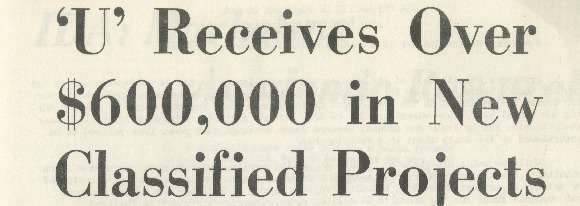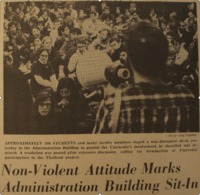Military Research
The Cold War University
Students and faculty in the antiwar movement protested military research at American universities and charged both the administration and professors who worked on classified government projects with complicity in the Vietnam War. Governments have the authority to define what is classified and what is not, and because of the sensitivity of the research, the public rarely knows the full extent of military research. Classified projects required enhanced security dictated by the Defense Department. As the UM administration became more and more intertwined in Cold War military research, the anti-war students became increasingly disgusted with secret research projects conducted at the university and coordinated by the government. In 1968, a Daily examination of “Military Research at Michigan” concluded: “We know that, essentially, today’s big university is just one more extension of the military-industrial complex: its board of trustees are dominated by bankers and industrialists; it depends on defense and other government contracts for half its resources and on the industry for much of the rest.”
UM President Harlan Hatcher served as a board member of the Institute for Defense Analyses (IDA), a partnership between the Defense Department and twelve research universities. The IDA served as a think tank for government research in war weaponry, providing “a means by which individuals from universities can come to grips with major problems of national security.” Oftentimes, professors would work in affiliation with IDA or leave for a year to work in IDA. In 1968, a Students for a Democratic Society expose charged that the IDA had nothing to do with education. In fact, “the value of a professor to a university is increasingly measured, certainly not by his teaching ability, and not even so much by his publication, but by the demand for his product in the market of the knowledge industry.” The Ann Arbor-area corporation Conductron allowed UM professors to profit from their war-related research and further illustrated the university’s links to the military-industrial complex. According to the Daily, “Conductron would learn about hot new research [at the university], then steal professors away – or at least the techniques – and then market the idea.”
Willow Run, a U.S. Army research lab, tied UM directly to the military and effectively turned the University into a corporation that conducted research for the federal government. According to a Michigan Daily investigation, government agencies controlled Willow Run, but the “University administers the lab,” including employment almost two hundred undergraduate and graduate students. The Army praised the University of Michigan as the “leading free world authority in surveillance technology,” and Willow Run played a major role in UM receiving $66.2 million in federal research contracts in 1967, the most of any university in the country. That same year, UM President Harlan Hatcher praised the Willow Run facility for its critical contributions to the war effort: “Reconnaissance and surveillance technology was brought into sharper focus by the situation in Vietnam, where allied forces rely heavily upon aerial surveillance for military intelligence.” SDS included this Hatcher comment in a guide to military research at UM in order to ask a rhetorical question: “When the main national purpose of the U.S. leaders is the military preservation of an economic empire, what can you expect of its universities?
Protesting the University-Military-Industrial Complex
Opposition to military research at UM emerged during the initial teach-in movement and then intensified during the fall of 1967. During the 1965 teach-in, a professor of chemistry named Irwin Goldstein criticized the U.S. military’s use of nerve gas in Vietnam and demanded the end of classified research to develop such weapons at the University of Michigan. Two years later, antiwar activists on campus targeted the University directly with an almost seven hour sit-in. Leading up to the sit-in, the administration refused to comment on protesters' demands. This silence changed on November 1, 1967. At one in the afternoon that day, a crowd of nearly 300 student activists entered the administration building where the office of the UM president and the vice president of research at the University. The protesters remained peaceful and, unlike similar protests at other universities, the police did not arrest any protesters. As a Michigan Daily article reported, "The most striking feature of yesterday's sit-in in the Administration Bldg. was its markedly refined, quiet one.” In fact, the dialogue between the administration and the students was respectful. A. Geoffrey Norman VP of research discussed the University’s policies on classified research with the protesters for two hours. This protest forced the administration to consider their accountability to the antiwar activists.
This sit-in was also the first time an organized group of professors has jointly sat-in. The professors complaints varied from the demand of open research to a human-rights arguments accusing the University of promoting the deaths of innocent people. Professor Anatol Rapoport, who left not only the University but the country because the US, he said, had become a war-machine, argued that the classified research “ not resulting in open knowledge is not keeping up with the basic function of a university” of “free dissemination of knowledge.” Professors Frithjof Bergmann, Nicholas Kazannoff, and Robert Sklar joined Rapoport in his concerns. Chemistry Professor Julian Gendell organized the professors for the sit-in. Perhaps the most illuminating faculty comment came from Sklar: “There is no excuse for the University to be used by the government to murder women and children.” This extreme disgust from a professor showed how classified research affected all parts of the University.
In response to the anti-war protests, the UM administration established the Elderfield Committee to review the policies for classified military research. The committee, headed by a prominent chemistry professor, defended the right of faculty members to engage in a military-related work on academic freedom grounds. In a mostly symbolic compromise, the Elderfield Committee did institute a new provision that “the University will not enter into any contract supporting research the specific purpose of which is to destroy human life or incapacitate human beings.” Students for a Democratic Society sharply criticized the Elderfield Committee for not even mentioning the Vietnam War and for approving all but one of the seven hundred classified research contracts in its first year of operation. “Since no U research is going to directly kill people,” SDS charged, “the policy is totally ineffective.”
In 1970, SDS compiled several exposes on the immorality of the University’s classified research for the government into one piece called “Strung Out.” Complete with illustrations of Willow Run looking like a top-security warehouse, the report detailed the University’s “hand in mouth” cooperation with government through the lab. Universities had been reduced to “big businesses with products (research) to sell.” The piece exposed the various high-UM elites and their connections to the governmental-sponsored research institutes, including quotes from UM professors supporting the war research they do. “Strung Out,” in total, summarized the extent of the University’s compliance to the government with their final thesis: “In particular, the University of Michigan is not neutral. It is an integral part of the American economic and social system. When that system conducts genocidal wars, it must be stopped. When universities like Michigan support such genocidal wars, they must be stopped”
Citations for this page (individual document citations are at the full document links).
“Defense for the Homefront,” n.d., Military Research at Michigan: A Reprint from October 17-20, 1967, Michigan Daily and Issues Through February 22, 1968, Pacifism - Military (anti) - Research, Labadie Special Collections, University of Michigan.
Cathy McAffee, “IDA: Marketing Academic Research,” n.d., Military Research at Michigan: A Reprint from October 17-20, 1967, Michigan Daily and Issues Through February 22, 1968, Pacifism - Military (anti) - Research, Labadie Special Collections, University of Michigan.
Steve Wildstrom, “The University of Michigan in IDA, ARPA, and Project Agile,” October 19, 1967, Michigan Daily and Issues Through February 22, 1968, Pacifism - Military (anti) - Research, Labadie Special Collections, University of Michigan.
Steve Wildstrom, “Secret Research: Uncle Sam Wants “U,” n.d., Military Research at Michigan: A Reprint from October 17-20, 1967, Michigan Daily and Issues Through February 22, 1968, Pacifism - Military (anti) - Research, Labadie Special Collections, University of Michigan.
Roger Rapoport and Steve Wildstrom, “What Makes Willow Run,” n.d., Military Research at Michigan: A Reprint from October 17-20, 1967, Michigan Daily and Issues Through February 22, 1968, Pacifism - Military (anti) - Research, Labadie Special Collections, University of Michigan.
Neal Bruss, “Conductronics: Course in ‘U’ Spinoff,” n.d., Military Research at Michigan: A Reprint from October 17-20, 1967, Michigan Daily and Issues Through February 22, 1968, Pacifism - Military (anti) - Research, Labadie Special Collections, University of Michigan.
Jim Heck, “‘U’ Receives Over $600,000 in New Classified Projects,” December 7, 1967, Military Research at Michigan: A Reprint from October 17-20, 1967, Michigan Daily and Issues Through February 22, 1968, Pacifism - Military (anti) - Research, Labadie Special Collections, University of Michigan.
Ken Kelley, “Faculty Members to Join Protesters at Research Sit-In: SACUA Hits Tomorrow’s ‘Disruption,’” The Michigan Daily, October 31, 1967.
Urban Lehner, “Faculty To Probe Thailand Project: Norman Asks Research Policy Unit To Review $1 Million ‘U’ Contract,” The Michigan Daily, November 1, 1967.
Daniel Okrent and Steve Wildstrom, “Non-Violent Attitude Marks the Administration Building Sit-In,” The Michigan Daily, November 2, 1967.
Sarah Bridger, Scientists at War: The Ethics of Cold War Weapons Research (Cambridge: Harvard University Press, 2015), chapter 5.
Irwin Goldstein,“Remembering University of Michigan Activism,” Michigan Daily, March 25, 2009.
Students for a Democratic Society, “Military Research at Michigan: A Short Guide,” 1970, Military Research at Michigan: A Short Guide, Labadie Special Collections, University of Michigan.
Students for a Democratic Society, “Strung Out: A Report on the Relationship Between the University of Michigan and the Military,” 1970, Labadie Special Collections, University of Michigan.


